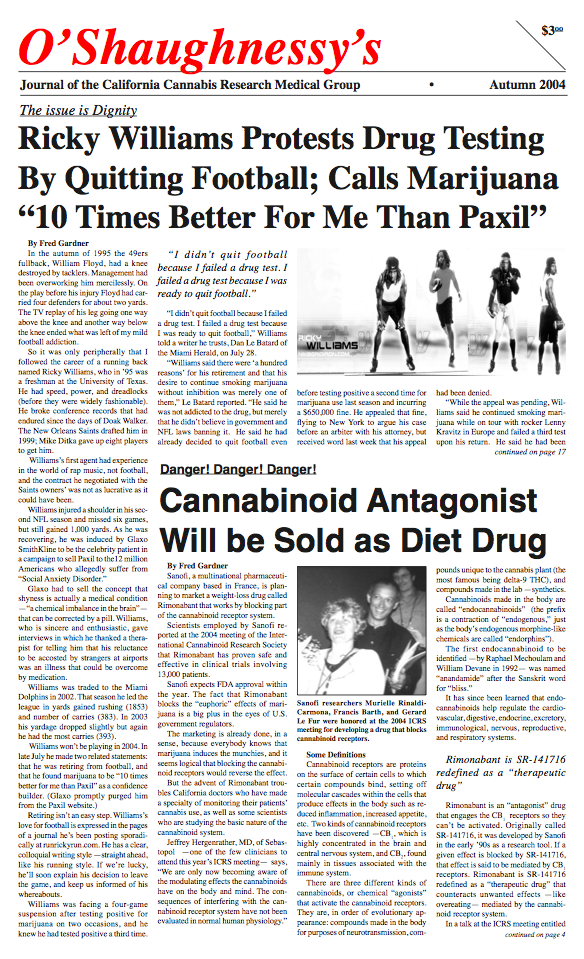By Fred Gardner
Sanofi would have saved the $40 million pay-out, plus the approximately 750 million euros spent bringing Rimonabant to market, had their top scientists heeded a warning from Jeffrey Hergenrather, MD, a country doctor from Sebastopol, California, at the 2004 meeting of the International Cannabinoid Research Society.
O’Shaughnessy’s reported Hergenrather’s misgivings on page one of our Autumn 2004 issue:
“Scientists employed by Sanofi reported at the 2004 meeting of the International Cannabinoid Research Society that Rimonabant has proven safe and effective in clinical trials involving 13,000 patients…
But the advent of Rimonabant troubles California doctors who have made a specialty of monitoring their patients’ cannabis use, as well as some scientists who are studying the basic nature of the cannabinoid system.
Jeffrey Hergenrather, MD, of Sebastopol —one of the few clinicians to attend this year’s ICRS meeting— warned, “We are only now becoming aware of the modulating effects the cannabinoids have on the body and mind. The consequences of interfering with the cannabinoid receptor system have not been evaluated in normal human physiology.”
Before marketing commenced, Hergenrather adivsed, “It would be ethical to design longitudinal studies to assess the consequences of interfering with the cannabinoid system.”
Our story was slugged “Danger Danger Danger!” It explained that
Rimonabant is an “antagonist” drug that engages the CB1 receptors so they can’t be activated. Originally called SR-141716, it was developed by Sanofi in the early ’90s as a tool for researchers investigating the endocannabinoid system. If a given effect is blocked by SR-141716, that effect is said to be “mediated” by CB1 receptors.
Being able to determine which metabolic effects involve CB1 receptors was a huge step forward for ICRS scientists. In recent years, numerous talks and posters have described what happens when SR-141716 is administered to rodents. Sure enough, appetite suppression was observed consistently.
Rimonabant is SR-141716 redefined as a “therapeutic drug” that counteracts unwanted effects mediated by the cannabinoid receptor system —like overeating.
Asked at the 2004 ICRS meeting how a drug could block the CB1 receptor system without adversely affecting mood, sleep, pain relief, and other CB1-mediated aspects of well-being, the Sanofi researchers answered vaguely that other neurotransmitters were likely to play compensatory roles. No pattern of adverse effects had been observed during the clinical trials, they claimed. Such effects were assumed to be so rare that they would not be detectable until Rimonabant had been used by millions of people over a period of years.
There were a few whispered criticisms and misgivings. A multiple sclerosis specialist told of a case in which Rimonabant apparently caused an immediate, extreme exacerbation. A physician wondered —since the body’s own cannabinoids have neuroprotectant and anti-oxidant functions—if Rimonabant users would be at increased risk for stroke and cancer. But the negative remarks were anecdotal or speculative; the positive data belonged to Sanofi.
Three Sanofi Rechercheurs accepted the ICRS’s 2004 achievement award on behalf of their company. It was presented by Raphael Mechoulam, the grand old man of the field, who wryly observed that Sanofi had shown great foresight in developing a weight-loss drug in the 1990s, because it had since swallowed up two much larger drug companies, Synthelabo and Aventis. (Today Sanofi is the world’s fourth largest pharmaceutical company in terms of sales).
Sanofi won approval from the EMEA to sell Rimonabant in 25 countries under various names devised by their marketing wizards. In England it was called “Acomplia.” The name in the U.S. was going to be “Zimulti.” But a funny thing happened on the way to Zimulti in the spring of 2007. The death toll from Vioxx had reached 50,000 —probably the most suppressed fact of the past decade— and the physicians on the U.S. Food and Drug Administration committee were, to use Gronbaum’s term, “spooked.” Hergenrather’s colleague Tod Mikuriya, MD, had written a letter to the FDA advising against approval, and he felt a small sense of achievement when the advisory committee announced its unanimous “Nix!”
In June 2008 the European Medicines Agency reviewed data from Sanofi’s clinical trials and withdrew its approval. Rimonabant users were found to suffer depression, anxiety, insomnia and aggressive impulses at twice the rate of subjects given placebo. In one study there were five suicides among Rimonabant users compared to only one among subjects on placebo. By not presenting the results of this study, Sanofi misled investors in the period between European approval and FDA rejection.
Unpublicized to date are adverse effects involving cancer, seizures, and other illnesses that the endocannabinoid system plays a role in suppressing.





